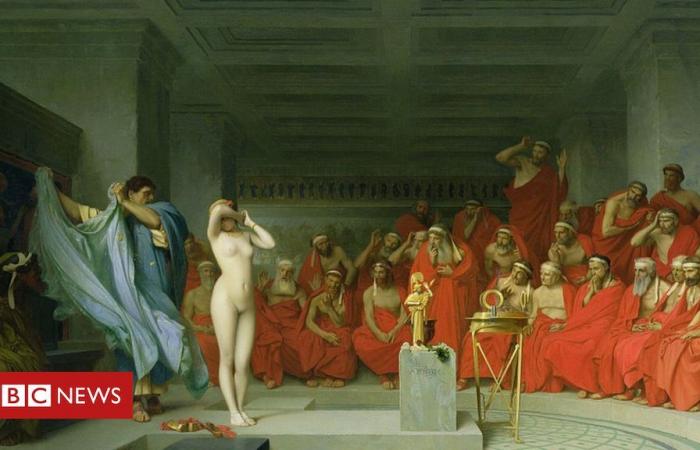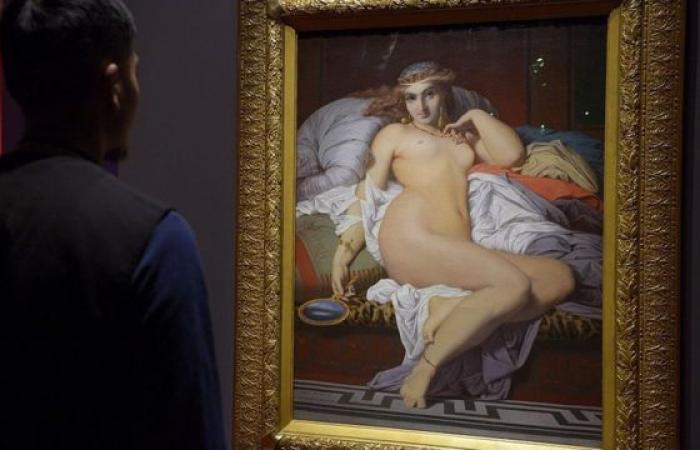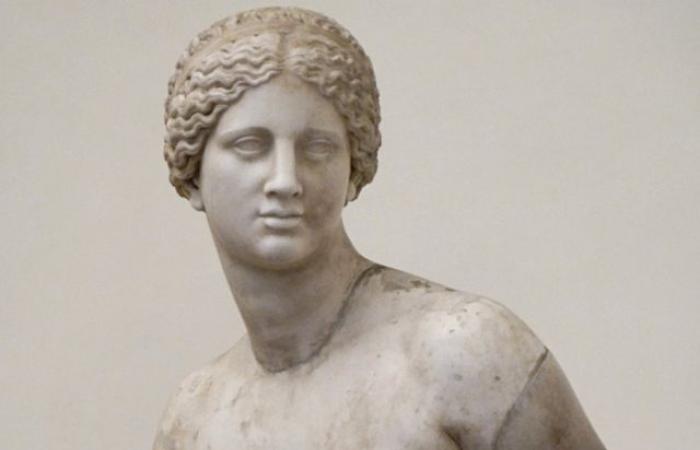- Dalia Ventura
- BBC World News
2 hours ago
Credit, Getty Images
‘Friné in front of Areóago’, by Jean-Léon Gerôme, was one of many works of art inspired by history
Things were not going well for the defense in Areópago, a place where, according to legend, Ares, the god of war, had been judged by the gods and convicted of killing Halirrotio, son of Poseidon, who had raped one of his daughters, Alcipe.
In the court, located a few meters from the Acropolis, in Athens, the defendant faced, one of the most serious accusations that could be made against any person: impiety, or disrespect to religious conduct or beliefs, one of the reasons why the great Athenian philosopher Socrates he had been sentenced to death.
Even with his preparation and effort, it was obvious that the talented Hiperides, one of the ten Attic speakers (they were a kind of lawyers of classical antiquity), was not able to convince the jury.
With his client’s life (and his own reputation) at stake, he took extreme measures.
“… as she was not achieving anything with her speech and it was likely that the judges would condemn her, after leading her to a very visible place and tearing her tunic, leaving her breast exposed, she declared her final lamentations at the sight offered for her … “, says the writer Ateneu de Náucratis in Two Scholars Banquet.
Hyperides had stripped before the jury, in that sacred place that had been watered with clean water before the trial to remind those present that everything that entered there must be pure, a hetaira.
Hetairas were a class of professional courtesans from Ancient Greece who, in addition to taking care of their physical beauty, cultivated their minds and talents to a much higher degree than the average woman was allowed.
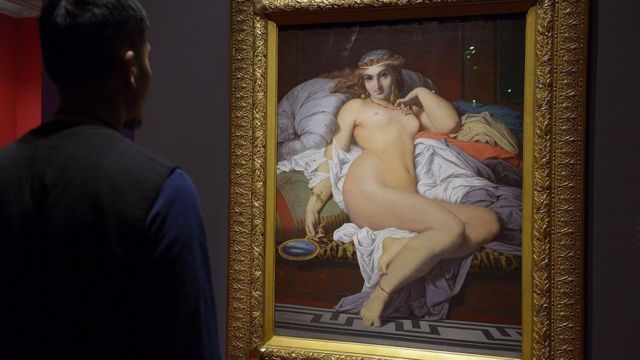
Credit, Getty Images
French painter Gustave Boulanger was another who was seduced by the beauty of Frine
Its name was Mnēsarétē, which means “celebrating virtue”, but it was known as Friné, which means “frog” and it seems an insult, but the nickname was not due to his features, but to the olive color of his skin.
She was born in 371 BC in Thespiae, but moved to Athens and, over time, became a celebrity who hid herself from public view with a veil.
“Friné was a very beautiful woman, even in the parts of her person that were not usually seen; it was not easy to see her naked, because she wore a tunic that covered her whole person and never used public restrooms,” wrote Ateneu.
Thus, only those who paid could see it … in the flesh.
Those who could not afford to do so, had the opportunity to admire her attributes in another way: because she was a highly sought after model by painters and sculptors, among them Praxiteles, the most renowned sculptor of the 4th century BC and that immortalized in one of the most famous works of art in Ancient Greece.
The Aphrodites
The Roman encyclopedist Pliny the Elder says that around 330 BC, the Greek island of Kos commissioned Praxiteles to make a statue of the goddess of love, beauty, pleasure, passion and procreation.
The artist sculpted not one, but two Aphrodites: dressed and naked.
Kos residents were horrified to see the second sculpture, so they kept the first. But his neighbors in Cnido were not so modest and kept the goddess naked.
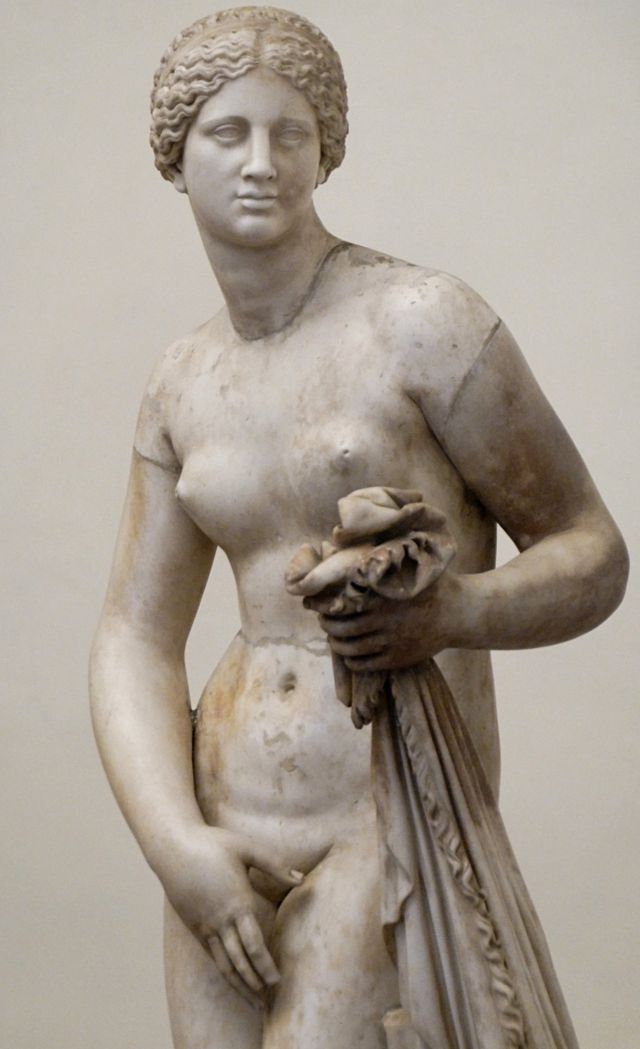
Credit, © Marie-Lan Nguyen
The original nude Aphrodite statue was lost, but copies still exist
The Roman historian says that King Nicomedes liked Praxiteles’ naked sculpture so much that he offered Cnido, in exchange, the forgiveness of his debts.
Although the Cnidians declined the offer, they managed to pay what they owed thanks to the fact that the naked Aphrodite became a tourist magnet.
The figure reproduced in stone also enriched the woman who owned it.
Thebes walls
In addition to her physical attributes, Friné was “a goddess of puns and practical thinking”, according to Athenaeus, who also recorded that she was possibly the wealthiest woman creator of her own success of her time.
She accumulated so much wealth that she offered to finance the reconstruction of the walls of Thebes, which were destroyed by Alexander the Great in 336 BC.
But he demanded that the words “Destroyed by Alexander, restored by Friné, the courtesan” be inscribed on the walls.
The idea of a woman (and above all a courtesan) rebuilding what Alexander the Great had destroyed was so disturbing to the city’s patriarchs that they preferred to keep the ruins.
And the trial?
Hyperides undressed Friné in front of the jury.
The courtesan was there because, as Athenaeus said, “during the Eleusinian and Poseidon festivities, in plain sight, she took off her tunic, loosened her hair and went into the sea”.

The Eleusinian Mysteries were the most famous of the secret religious rites of ancient Greece, and this was how the 19th century Polish painter imagined Phryne during the festival.
They accused her of desecrating the party with her offering, and Hyperides showed how she had committed the crime.
It was such a perfect body that it could only be made by the gods, he argued. It would be disrespectful for them to deprive the world of this divine work.
How could they condemn a woman who was so beautiful that she had played Aphrodite?
“… and made the judges feel a reverent respect for Aphrodite’s minister and servant, guaranteeing by religious devotion that she should not be killed,” wrote Athenaeus.
The truth is that the story of the Phryne trial was recreated based on a few passages of writings at the time and reports by authors who are not present.
It is known that the trial took place and that Hyperides’ speech in his defense was one of the most admired in antiquity, but only a few fragments remain.
There are also doubts about the cause that led to the prosecution, and there is another version of the ending, in which Friné herself, dressed, speaks to each of the jurors and convinces them of her innocence.
None of this prevented the dramatic litigation from inspiring several works of art, from paintings like the ones that illustrate this report and several others, to sculptures by artists like the American Albert Weine.
Poets like Charles Baudelaire, Francisco de Quevedo and Rainer Maria Rilke wrote thinking about Friné, the French Camille Saint-Saëns created an opera that bears his name, and the Italian Mario Bonnard directed a film about the courtesan.
Splendid legacy of the trial, although we have no evidence of the veracity of the facts.

Have you watched our new videos on YouTube? Subscribe to our channel!
These were the details of the news Phryne: the dramatic trial of the Ancient Greek courtesan who undressed... for this day. We hope that we have succeeded by giving you the full details and information. To follow all our news, you can subscribe to the alerts system or to one of our different systems to provide you with all that is new.
It is also worth noting that the original news has been published and is available at time24.news and the editorial team at AlKhaleej Today has confirmed it and it has been modified, and it may have been completely transferred or quoted from it and you can read and follow this news from its main source.

